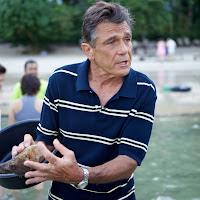
Giant squid can
grow to an awesome size with their bodies reaching 2 metres in length and a
weight of 275 kg. When you add the eight shorter arms used for holding and the
two long tentacles used for grabbing prey, giant squid can be up to 13 metres
long. The giant squid is the second largest mollusc loosing first place to the
colossal squid.
The first photos
of a live giant squid in its natural habitat were taken during September, 2004
by researchers from the National Science Museum of Japan and the Ogasawara
Whale Watching Association using special underwater cameras.
The image is used here
strictly for educational purposes. Original copyright for this image:
"Copyright (C) Kyoto Prefecture
Marine biologists
have discovered that giant squid feed on deep-sea fish and smaller squid. They
catch their prey using the two muscular tentacles which are armed with
sharp-edged suckers on the ends. The food is brought back toward the mouth
where a powerful beak (like a parrot beak) tears it to pieces. The pieces are then shredded with the
radula (a tongue with small teeth) and swallowed.
While suckers are
found only on the ends of a squids two tentacles, they are also found along the full
length of the inside of the eight arms. Suckers on the arms are smaller (2-5cm)
but there are hundreds of them.
It is thought
that the only things powerful enough to eat a grown giant squid are sperm
whales and the huge Pacific sleeper sharks found in freezing depths.
Scientists often find circular scars left by the sharp suckers on the head of
sperm whales. Who usually wins the gigantic battles thousands of metres below
the surface is unknown.
Giant squid have
three hearts: one for each of the two gills and one for the body. They have a
very advanced brain able to deal with all the muscles and sensory nerves. They
also have the largest eyes of any living creature (except for the colossal
squid) — at more than 30 centimetres.
Giant squid are
found in all of the world's oceans. They are usually found near continental and
island slopes that drop into the depths of the abyss. They like cold, deep
water and are seldom found in tropical and polar latitudes.
http://youngmarinescientist.blogspot.com/
http://geraldgoeden.blogspot.com/
http://goedensnews.blogspot.com/
http://goedenquotes.blogspot.com/
http://gerrygoeden.blogspot.com/
http://goedenscience.blogspot.com/
http://goedenmarineecology.blogspot.com/
http://goedenshark.blogspot.com/
http://gerryquotes.blogspot.com/
http://einsteinsnature.blogspot.com/
http://drgerrygoeden.blogspot.com/








